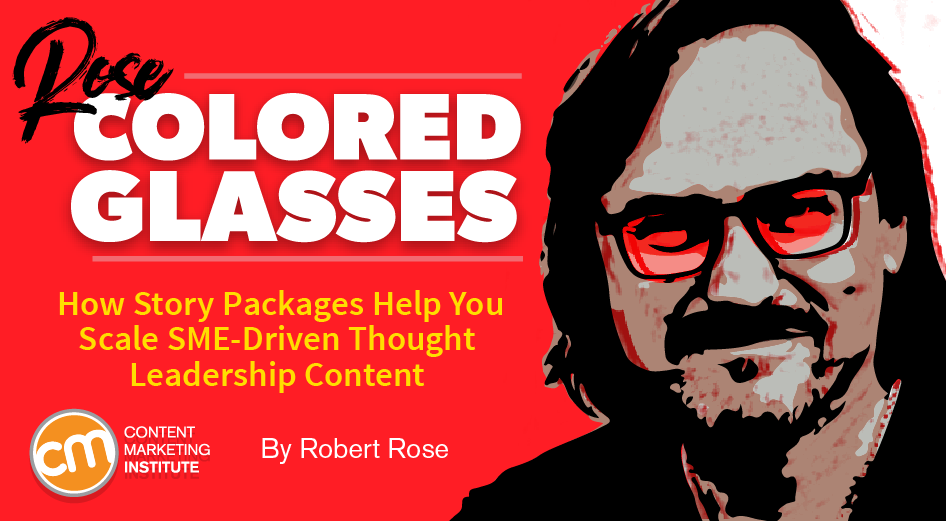MARKETING
How Story Packages Help Scale SME-Driven Thought Leadership Content

You know that feeling when you’re watching a movie, and a character suddenly starts explaining things in so much detail you find yourself pulled entirely out of the story?
You experienced an “info dump.” And I bet you didn’t like it.
The most familiar movie info dumps usually involve the villain explaining their entire plan to the story’s hero, laying it out in (sometimes) excruciating detail that delays the action.
But many beginning storytellers rely on info dumps in the introductions to their stories. They over-explain situations or characters to the point where the audience knows more than they need to and gets bored.
The introduction info dump is especially common in stories set in a fantasy world. Technically, the text crawl at the beginning of every Star Wars movie is an info dump. But they’re short (the original Star Wars intro is only 82 words) and presented in such a unique way that the audience doesn’t mind.
Did you notice that the introduction to this article is an example of an info dump? I hope it’s an entertaining one.
Info dumps aren’t inherently wrong. But when done poorly, they prevent the content from having any other value.
Watch out for info dumps in your #Content. They’re not inherently wrong, but if not done well, they risk ruining the value, says @Robert_Rose via @CMIContent. Click To Tweet
Info dumps in content marketing
Unfortunately, introduction info dumps have become staples of content marketing articles. They’re usually added to try for better organic search results.
But they don’t always serve the audience. Put yourself in their shoes: Imagine you decide to do a Google search for the “best marketing automation software.” You’d probably want to find a specific recommendation or a list of the best software solutions.
You click on a promising link labeled Best Marketing Automation Software in 2023 and get to an article structured like this:
- 420 words of introduction telling you what to expect in the article
- 530 words of information telling you what marketing automation is and why you might not need a marketing automation solution
- 200 words of introduction to the software list
- 2,500 words presenting descriptions of the software options in the list
Add that up, and you have a “meaty” article of approximately 3,600 words. But about 30% was an introductory info dump that (from an audience perspective) didn’t need to be there.
More and more, I find myself scrolling about halfway down in any article (or fast-forwarding the first third of videos) to get to the promised value in the content.
Before the SEO-minded jump in to tell me why this approach is required for building high-ranking pages, know this is a minor annoyance to me as a content consumer.
The insidious danger of info dumping comes from how it hurts your thought leadership.
The danger of info dumping lies in how it delays thought leadership, says @Robert_Rose via @CMIContent. Click To Tweet
Info dumping in thought leadership
My clients in specialized industries (e.g., financial services, technology, and health care) often ask for advice on how to work better with the subject matter experts who provide the brand’s thought leadership. (The SME challenge was a pain point in CMI’s latest B2B research, too.)
Content marketing practitioners often depend on subject matter experts to provide content (usually written) to feed the desired cadence for their publishing calendar. But subject matter experts might explain their thoughts, theories, findings, and conclusions in such thorough detail it’s hard for the content team to home in on the relevant portions.
Occasionally, this results in ridiculously long lead times for articles and position papers.
I spoke with the head of content marketing at one B2B technology company whose content team published only one article in six months because the engineers kept adding more and more technical detail.
The content marketing leader told me she couldn’t keep up with the demand for content because it takes so long to create any one piece.
My advice was a bit counterintuitive. I told her that this timeline for large content pieces might be unavoidable. But the solution isn’t to ask for more or involve more engineers.
Instead, I told her to call the info dumpers’ bluff. In other words, I advised her to help the engineers lean into the big idea and provide a more structured piece so the content team gets everything it needs to create a whole portfolio of content from it.
The answer to long #Content development time? Ask your SMEs for structured content, says @Robert_Rose via @CMIContent. Click To Tweet
HANDPICKED RELATED CONTENT:
Go long on short-long content
Often, SME-driven info-dumping articles that take weeks or months to produce are just information-heavy short articles. They use 5,000 words to make a point that could have been made in 500 words.
If an article, white paper, or video script takes weeks to work through with SMEs, create a full accounting of all the content you need upfront. That way, you can reuse or repackage that big idea that took so long to develop at different points in the audience journey.
For example, the technology company I mentioned specializes in cybersecurity. One SME-driven article that landed on the content team’s desk was a highly technical thesis about the company’s design approach and how it helps solve particular regulations and standards.
As an asset for potential buyers deep in the selection (or implementers) of a solution, that content might make a valuable piece of thought leadership.
But to anyone less technical who might drive a company’s initial interest in the unique approach, that content was almost useless.
What was missing? All the other pieces to the story.
Architected story packages
I’ve found architected story packages helpful in modularizing big stories into reusable components. Architected story packages can scale content initiatives to cover the entire audience journey.

The package comprises four content archetypes, each with an increasing number of attributes:
- Performer (draw attention with the attribute of emotional stimulus)
- Promoter (inspire action with the attributes old world, trigger, and new world)
- Professor (persuade and convince with the attributes of a thesis, challenge, implication, justification, and opinion)
- Poet (change core beliefs with the attributes hero, constriction, desire, resistance, relationships, adventures, and truth)
The technology company content leader wanted to create a thought leadership piece, so the professor model fit. The content piece would need to address these attributes:
- Thesis – why the company’s cybersecurity design principles answer essential questions
- Challenge – the specific business or other challenge(s) the thesis will ultimately solve
- Implications – the good and bad implications of following the thesis and solving the challenges
- Justification – the proof points for why solving this challenge in this way will benefit the reader
- Opinion – how the brand’s specific approach to this solution works
The content leader had only been getting info dumps of detailed, technical proof (opinion) that the company’s approach to cybersecurity was effective. The only attribute that SME content addressed was opinion.
The content leader worked with the SMEs to fill in the other pieces to that puzzle. By asking for an even more detailed (but more structured) piece, the content leader ensured she’d have a toolkit of content that the team could use to create blog posts, podcast episodes, short-form articles, and even long-form e-books. That lengthy content development period provided content that could roll out for several months at several parts of the audience journey and to a broader audience segment.
Aim for full coverage
The filmmaking term “coverage” refers to the idea of shooting many versions of a scene (wide angle, two-shots, close-ups, etc.) to provide the director flexibility to package the story in different ways in editing.
The story package process is similar. If you spend a meaningful amount of time waiting for subject matter experts who want to explain everything thoroughly, then make sure the waiting period pays off. Take the time to capture all the elements of the story. You’ll end up with the flexibility to tell it in multiple ways for different uses.
Put simply, you’ll be able to transform the info dump through info-cycling – a much more effective use of all your ideas.
It’s your story. Tell it well.
Get Robert’s take on content marketing industry news in just five minutes:
Watch previous episodes or read the lightly edited transcripts.
Cover image by Joseph Kalinowski/Content Marketing Institute



![Scale Efforts and Drive Revenue [Webinar] AI & Automation for SEO: Scale Efforts and Drive Revenue](https://articles.entireweb.com/wp-content/uploads/2024/10/Scale-Efforts-and-Drive-Revenue-Webinar-400x240.png)
![Scale Efforts and Drive Revenue [Webinar] AI & Automation for SEO: Scale Efforts and Drive Revenue](https://articles.entireweb.com/wp-content/uploads/2024/10/Scale-Efforts-and-Drive-Revenue-Webinar-80x80.png)








You must be logged in to post a comment Login